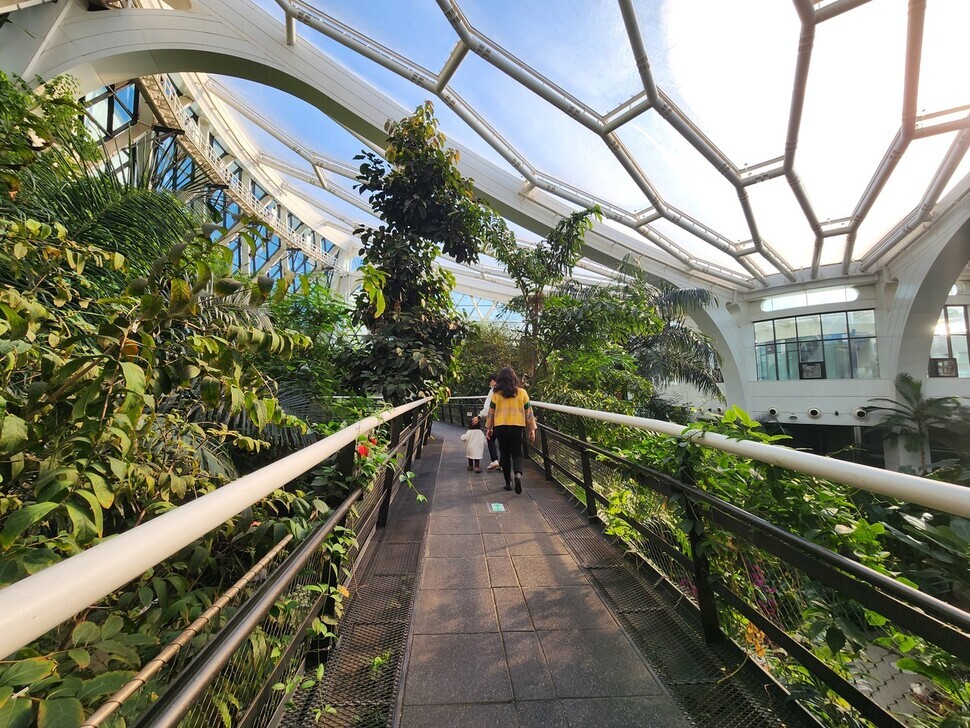
The skywalk at Seoul Botanic Garden allows visitors to get a closer look at the towering tropical plants there. (Her Yun-hee/The Hankyoreh)
“It’s so cold. Gosh, it’s cold.”
The words come out automatically. Though they say winter is best when it’s cold, sometimes the frigid temperatures can be too much to bear.
On days when even strong heat packs are useless, I want to leave for a warm country, south of the equator. At times like these, it’s a great idea to go on a small trip to a greenhouse in search of some warmth. But it’s important to take off your winter coat before entering. Just being inside the greenhouse makes you sweat.
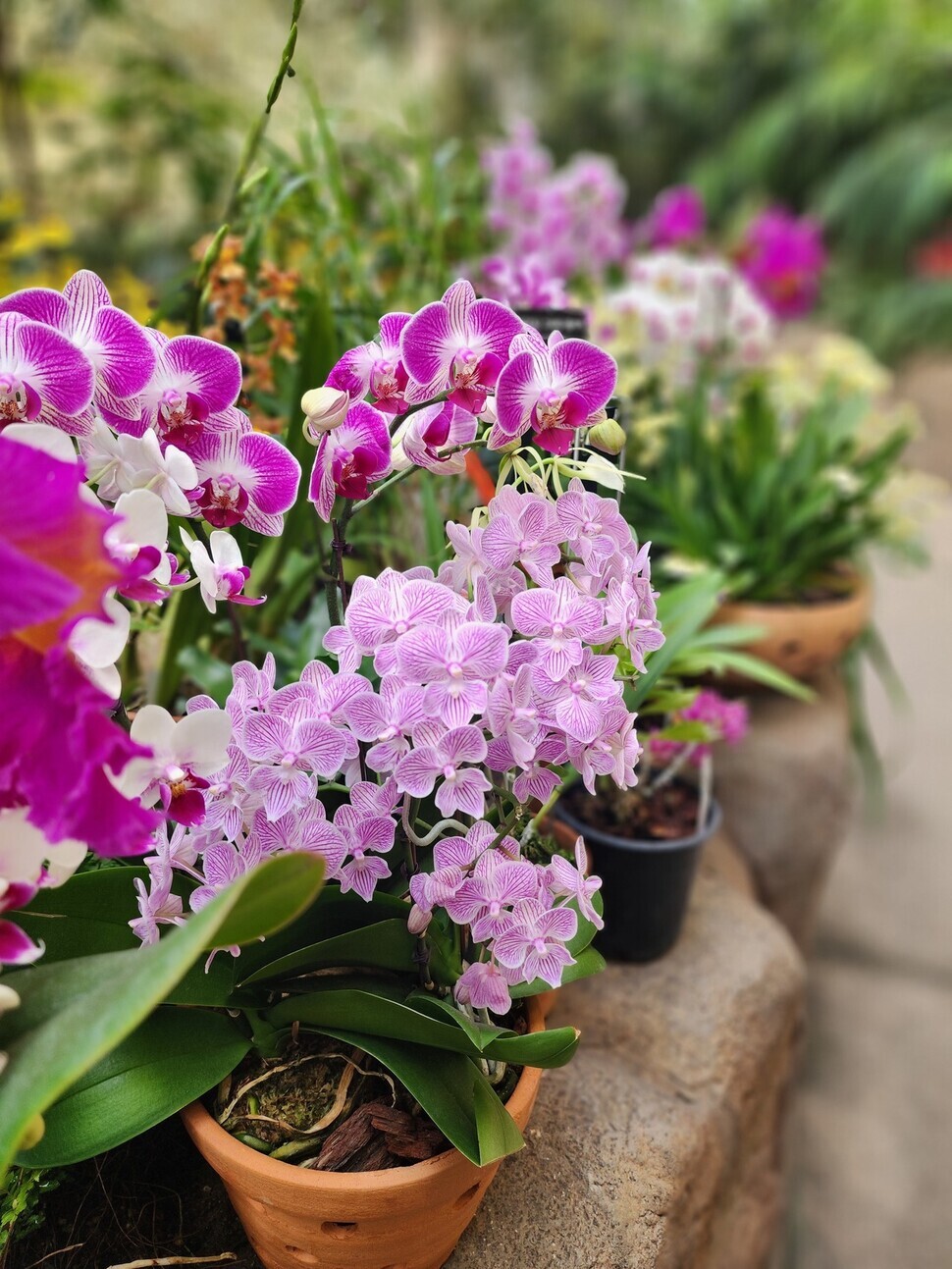
Colorful orchids can be found at the Seoul Botanic Garden. (Her Yun-hee/The Hankyoreh)
A tropical climate in the middle of winter
“It’s hot when you enter! Did you feel the hot air? Where you are now is the tropical region. Tropical climates with high temperatures and heavy rain are located near the equator, where the coldest months are over 18 degrees Celsius.”
This explanation came from the audio guide introducing the botanic garden.
It’s Dec. 28 and I’m at the Seoul Botanic Park in the Magok neighborhood of Gangseo District. Although it’s minus 2 degrees outside, inside the botanic garden it’s a balmy 20 degrees with a humidity level of 70%. The combination made it feel like stepping into summer.
The Seoul Botanic Park covers an area of 504,000 square meters, which is about 70 times the size of a soccer field. The park is divided into four areas: the Forest Field, the Botanic Garden, the Lake Garden, and the Wetland. Among these, the botanic garden is an indoor greenhouse facility that houses tropical and Mediterranean sections.
It’s a popular greenhouse trip destination with an average of 1,564 visitors per day in 2022 (from January to November).
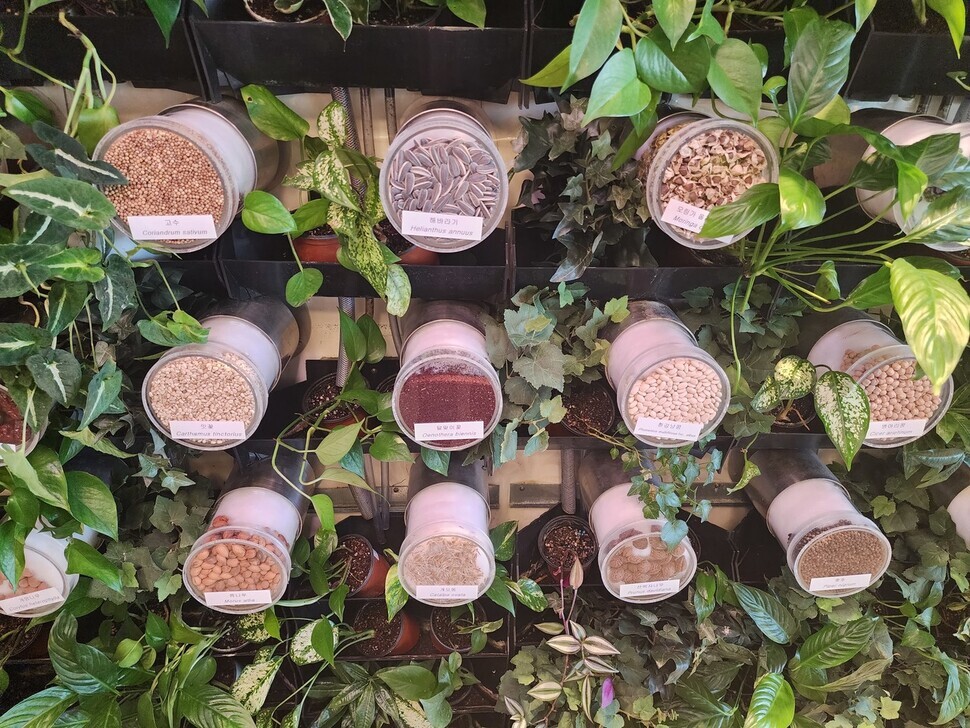
The Seoul Botanic Garden’s seed library allows visitors to take seeds freely to plant themselves. (Her Yun-hee/The Hankyoreh
In the tropical section of the garden, flora from four cities, including from Jakarta and Hanoi, are on display. Plants that normally grow in hot and humid climates, such as mangoes, coconut palm, and walking palm (Socratea exorrhiza), were all growing lush in this section. Sprinklers were splashing and the sound of water, monkeys and birds filled the greenhouse. It felt like entering a dense tropical rainforest.
Red, yellow and all kinds of colorful orchids were nestled among the tropical trees on one side of the tropical garden.
Something to take note of is that the Seoul Botanic Park will be displaying more than 20 species of tropical orchids, including Cattleya, Dendrobium, and Oncidium, in its winter exhibition, scheduled to run through March. The idea is a reproduction of the “winter garden” glasshouses of 19th-century Victorian England.
After passing through the tropical garden section, I moved onto the Mediterranean section. Unlike in the tropical garden, you can really feel the dryness and cooler temperature in the Mediterranean garden. Here, plants from cities in eight countries are on display, including from Greece, Australia, and Turkey.
Some of the plants here include Dracaena, olive trees, agave, date palms, and Mediterranean cypress, all of which grow in a temperate Mediterranean climate throughout the year. Next to the baobab tree, which is a popular backdrop for photos in this garden, there is a sculpture of the Little Prince.
“It would be good to compare and observe the leaves of coconut palms, cacao trees, and banana trees, which are not commonly seen in the tropical garden, and to carefully look at the colors and shapes of the various cacti in the Mediterranean garden,” Kim Young-jin, Seoul Botanic Park’s forest guide, said, giving a useful tip for the tour.
The skywalk in the botanic garden is the highest observatory point of the greenhouse. At 8 meters, visitors can see both the tropical and Mediterranean areas from here. You can even see the leaves and fruits of tall tropical plants up close.
Besides the greenhouse, the park offers other facilities which are also worth using such as a seed library, a garden research center, and a plant library. The seed library has about 500 kinds of seeds on display. Visitors can even borrow the seeds from the library, just like books. Anyone can borrow seeds for free, grow them, and then freely return the seeds that they harvest.
The plant library includes around 1,000 specialized texts on Korean and overseas plants, including books on botany, ecology and landscaping.
Admission to the Seoul Botanic Park is 5,000 won for adults. During the winter (November to February), it’s open from 9:30 am to 5 pm, with the last visitor admissions at 4 pm.
There’s another location in central Seoul where visitors can view a greenhouse while touring one of the city’s historic palaces: Changgyeong Palace, which is found in the Waryong neighborhood of Jongno District.
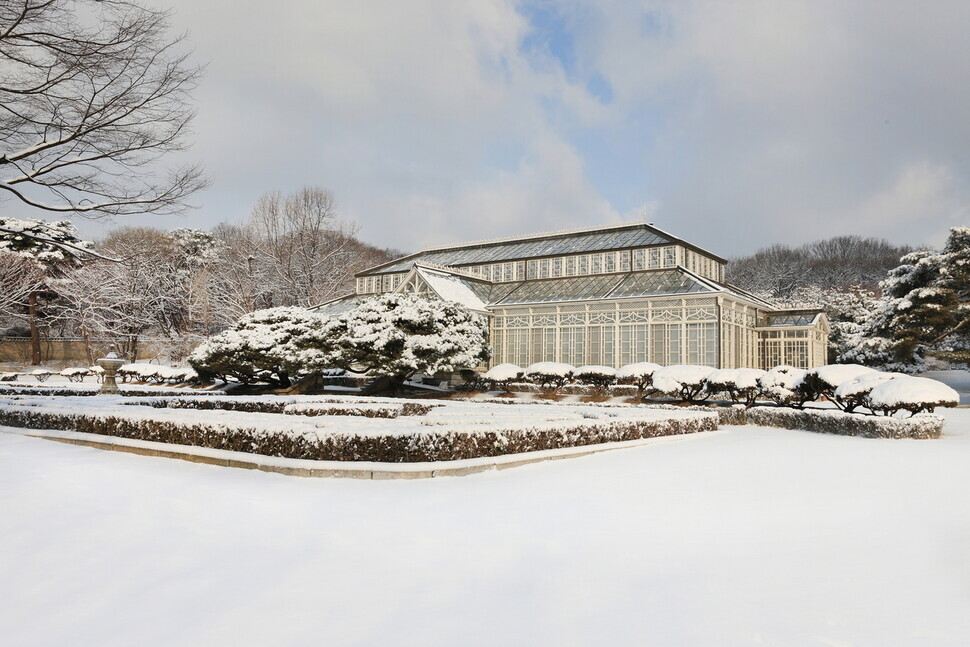
The Grand Greenhouse in Changgyeong Palace is a sight to behold in winter. (courtesy of the Cultural Heritage Administration)
Located inside the palace is the Changgyeong Palace Grand Greenhouse. Completed in 1909, it was Korea’s first-ever Western-style greenhouse.
The white structure has a steel and wood frame and is encircled in glass. Although it looks beautiful, the greenhouse harbors a tragic history: Imperial Japan had the structure built to “comfort” the last Korean Emperor Sunjong after his confinement in Changdeok Palace.
In 2004, the greenhouse was designated a national registered cultural heritage site in recognition of the glimpse it offers at the Western architecture introduced in the late stages of the Korean Empire. It has around 70 species such as ferns and carnivorous plants, along with plants grown from National Monuments such as the Changdeok Palace juniper, a paperplant on Bijin Island off the coast of Tongyeong, and a box-leaved holly plant in the village of Junggye in Buan County.
Visitors in the winter can see camellias in full bloom and natsumikan trees bearing fruit. Access to the greenhouse is provided with regular admission to Changgyeong Palace (1,000 won).
“The Changgyeong Palace Grand Greenhouse faces south, so it gets excellent sunlight,” explained Park Ju-yeon, a staff member with the Changgyeong Palace Management Office’s facilities management team, adding that the “best time to view the plants is between 2 and 4 pm, when the lighting is especially good.”
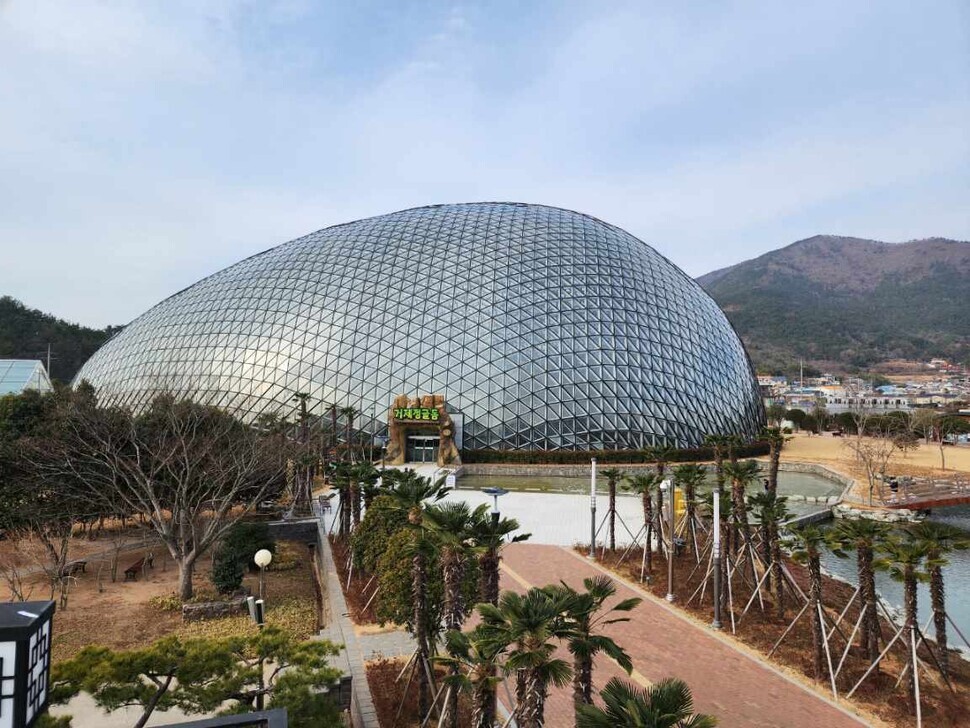
The Geoje Botanic Garden boasts an interesting domed shape. (courtesy of the Geoje Botanic Garden)
Seeing a magic show and hearing about plant life
Those who venture outside the city can encounter unique greenhouses and botanical gardens in other parts of Korea. The botanical garden at Seoul Grand Park in Gwacheon, Gyeonggi Province, offers programs and exhibitions centering on plants. It is also presenting three botanical garden tours with a magician on Jan. 14 and 28 and Feb. 11 — a program that combines magic performances with explanations on the flora.
For the month of January, the specimen gallery at the garden’s display greenhouse will be showing 25 miniatures that include the Asian beach jackbean and Korean daisy, both indigenous plant species.
The World Flower Botanical Garden in Asan, South Chungcheong Province, presents around 3,000 species of ornamental plants such as daffodils, callas, and chrysanthemums. It also offers gardening-based activity programs such as flower handkerchief dyeing and repotting.
Those who purchase a voucher (8,000 won) can use it to purchase plants and gardening items. Visitors are allowed to bring pets along.
The Geoje Botanical Garden is one of the top destinations in Geoje, South Gyeongsang Province, allowing visitors to see plants that grow in different climates such as tropical, warm temperate, and temperate. The dome-shaped structure has an area of 4,468 square meters and is made up of 7,472 panes of glass.
Inside the dome are around 300 species and 10,000 varieties of tropical trees. The interior consists of different spaces, including a stone art flowering plant garden, a stone art valley, a photo zone, a cactus garden, and a cave of light. Admission is 5,000 won for adults.
Jeju Island also has a greenhouse site that is worth visiting: the Yeomiji Botanic Gardens in the Jungmun Tourist Complex.
With a name meaning “beautiful land,” it comprises an external garden measuring 112,200 square meters and an internal garden measuring 11,361 square meters. The internal garden offers various themed sections that include a flower garden, water garden, cactus garden, and tropical garden.
By Her Yun-hee, staff reporter
Please direct questions or comments to [
english@hani.co.kr]







![[Column] A year and a half of Yoon’s foreign, security policies has added to Korea risk [Column] A year and a half of Yoon’s foreign, security policies has added to Korea risk](https://flexible.img.hani.co.kr/flexible/normal/500/300/imgdb/original/2023/1226/1517035766989839.jpg) [Column] A year and a half of Yoon’s foreign, security policies has added to Korea risk
[Column] A year and a half of Yoon’s foreign, security policies has added to Korea risk![[Column] Korea’s diaspora discrimination [Column] Korea’s diaspora discrimination](https://flexible.img.hani.co.kr/flexible/normal/500/300/imgdb/original/2023/1225/3417034701814775.jpg) [Column] Korea’s diaspora discrimination
[Column] Korea’s diaspora discrimination